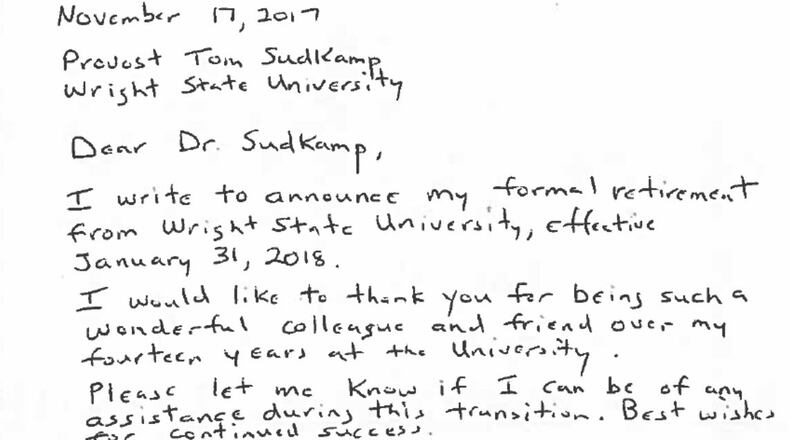“I would like to thank you for being such a wonderful colleague and friend over my fourteen years at the university,” said the note to Sudkamp. “Please let me know if I can be of any assistance during this transition. Best wishes for continued success.”
Hopkins’ personnel records show he cashed out $1,791 in vacation pay and $16,156 in sick leave. His salary at retirement was $200,000.
Hopkins resigned from the Wright State presidency on March 17, around three and a half months before he originally planned to retire from the office.
With his resignation as president, Hopkins was set to receive $150,000 in deferred compensation. If he had finished his term as president, Hopkins was to be paid $432,000 for one full year after leaving office, according to his contract.
Hopkins was replaced with interim president Curtis McCray before Cheryl Schrader took over the job on July 1.
Instead of completely leaving the university last March, Hopkins returned to a faculty position, though he never actually taught again at Wright State.
In the last few years of Hopkins’ presidency, Wright State was embroiled in budget issues that led to layoffs and more than $30.8 million in budget cuts last June. Despite the issues that outlasted Hopkins’ term as president, board of trustees chairman Doug Fecher said that Hopkins should be remembered for “all of the good” he was able to accomplish.
“I think Dave did a lot of good for the university. He was the university’s greatest ambassador, and we need to recognize that,” Fecher said. “I don’t think there’s any ill feelings. I think the university is moving on as it should.”
Although Wright State was once a growing and flourishing school under Hopkins, he ended up leaving behind a legacy of mixed results.
After rising to the presidency from the provost position, Hopkins oversaw the construction of the university’s Neuroscience Engineering Collaboration Building, the Student Success Center, the Wright State Physicians building and the expansion of the Creative Arts Center. Hopkins oversaw the university’s “Rise. Shine” campaign, which raised more than $160 million.
Hopkins’ history at Wright State is also marked with a lost presidential debate and numerous investigations.
As president, Hopkins oversaw the expansion of Wright State Applied Research Corporation, which ended up the target of a federal investigation into potential illegal abuse of work visas — leading to the removal of high-level university administrators — and spurred other controversies.
A Dec. 12 Ohio Inspector General investigation into a controversial WSARC consultant said Hopkins was “removed” from his position and was no longer at WSU. When asked about his status at that time, a university spokesman said he “is still employed by WSU” and no record of a separation agreement exists.


